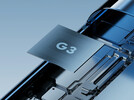Google Tensor G2 vs Google Tensor G3
Google Tensor G2
► remove from comparison
The Google Tensor G2 SoC is a chip that was developed by Google and Samsung for the Google Pixel smarthpones. It is the successor to the Google Tensor G1 and still integrates the same CPU cores. This processor part includes two fast ARM Cortex-X1 cores at up to 2.85 GHz (up from 2.8 GHz of the G1), two mid-range Cortex-A78 cores at up to 2.35 GHz and four small ARM Cortex-A55 efficiency cores with up to 1.8 GHz. The caches are identical with 4 MB CPU L3 cache and 8 MB system level cache. Therefore, the CPU performance is very similar to the first generation of the Tensor SoC.
A big upgrade is the new TPU, which should be more powerful and power efficient compared to its predecessor. In our tests, the AI performance is about 50% higher.
The iGPU was also improved, and now uses a more modern ARM Mali G710 architecture with 7 cores.
The chip also integrates a Titan M2 security processor, a LPDDR5 memory controller, and an ISP for 10-bit HDR / 4k/60 video and 108 MP cameras.
The SoC is manufactured in 5nm at Samsung.
Google Tensor G3
► remove from comparison
The Tensor G3 marks the third generation of Google's own chipsets for smartphones and tablets based on Android. This SoC is used for the first time in the Pixel 8 and Pixel 8 Pro and Google sees the SoC as a high-end device.
The CPU of the Tensor G3 is composed of three clusters. The first houses a single powerful Cortex-X3 core, which can operate at up to 2.91 GHz, the second offers four performance cores (Cortex-A715) with up to 2.37 GHz and the third cluster has four efficiency cores (Cortex-A510) with up to 1.7 GHz. The clock speeds are therefore not particularly high, so that the pure CPU performance is more on the level of an upper-middle-class SoC.
An ARM Mali-G715 is used as the graphics unit. Google is silent about the exact number of cores, but the benchmarks and the lack of ray tracing suggest a version with seven cores (G715MP7).
The core of the Tensor SoCs is the Tensor Processing Unit (TPU), which is responsible for AI and ML tasks. Here, too, Google owes the public more precise information and only talks about the fact that 150 times more complex AI models can be calculated on the device.
In addition, Google integrates its isolated security core subsystem, which again uses the Titan M2 co-processor and provides additional protection for its own data on a hardware basis. The G5300i modem is based on the Exynos 5300 and supports Wi-Fi 7.
The Tensor G3 is manufactured in the current 4nm process at Samsung.
| Model | Google Tensor G2 | Google Tensor G3 |
| Codename | Cortex X1 / A76 / A55 | Zuma - Cortex X3 / A715 / A510 |
| Clock | 1800 - 2850 MHz | 1700 - 2910 MHz |
| L3 Cache | 4 MB | 4 MB |
| Cores / Threads | 8 / 8 | 9 / 9 1 x 2.9 GHz ARM Cortex-X3 4 x 2.4 GHz ARM Cortex-A715 4 x 1.7 GHz ARM Cortex-A510 |
| Technology | 5 nm | 4 nm |
| Features | ARM Mali-G78MP20 GPU | Wi-Fi 7, Bluetooth 5.3, LPDDR5x-RAM, Dual-Band GNSS, Titan M2 |
| iGPU | ARM Mali-G710 MP7 | ARM Mali-G715 MP7 ( - 890 MHz) |
| Architecture | ARM | ARM |
| Announced | ||
| Manufacturer | store.google.com | store.google.com |
Benchmarks
Average Benchmarks Google Tensor G2 → 100% n=22
Average Benchmarks Google Tensor G3 → 108% n=22
* Smaller numbers mean a higher performance
1 This benchmark is not used for the average calculation











